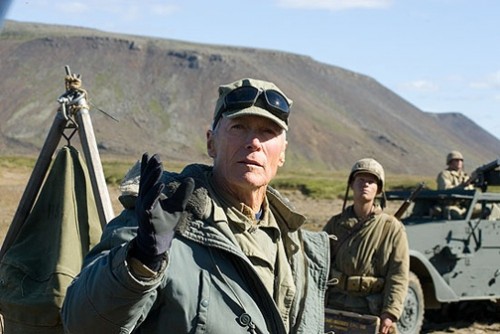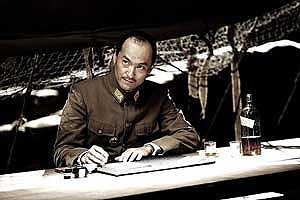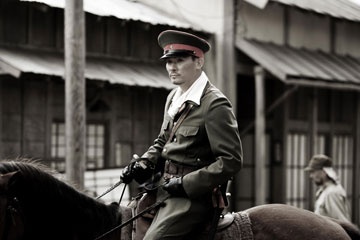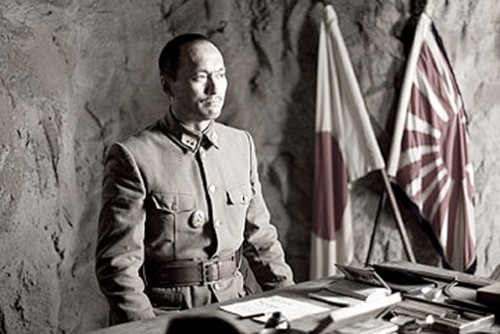Clint Eastwood's Letters from Iwo Jima
Japanese language version of World War Two battle
By: Charles Giuliano - Jan 09, 2007

Director Clint Eastwood on location.

Raising the American flag over Mount Suribachi on Iwo Jima.

Ken Watanaba portrays General Kuribayashi.

Baron Nishi, (Tsuyishu Ihara) an Olympic medalist, took his horse to Iwo Jima.

The Japanese commanders survey the battle scene.

The General prepares for battle.

Letters From Iwo Jima
Directed by Clint Eastwood, Screenplay by Iris Yamashita, Based on the book "Picture Letters from Commander in Chief" by Tadamichi Kuribayashi and Tsuyoko Yoshido, Produced by Clint Eastwood, Steven Spielberg and Robert Lorenz Warner Brother Pictures, Starring: Ken Watanaba, Kazunari Niniomiya, Tsuyoshi Ihara, Ryo Kase, Shidou Nakamura. Running time 141 minutes.
It was late in the war, April 12, 1945, when President Franklin D. Roosevelt died and former Vice President Harry Truman inherited the most difficult single decision of any individual in the 20th century. He ordered the nuclear bombs dropped on Hiroshima and Nagasaki on August 6 and 9, 1945. The Japanese surrendered on August 15. To date it is the only time when these most formidable weapons of mass destruction have been used. The intelligence available to Truman estimated the potential loss of a million American lives if the military executed a strategy of invading mainland Japan with conventional weapons. The use of incendiaries and the firebombing of Dresden resulted in a greater loss of life than was inflicted by the atomic bombings. Several years ago we visited Dresden which is still rebuilding more than a half century after the war.
To the victor go the spoils including the moral imperatives. For the patriotic American psyche dropping the A Bombs was payback for the "sneak attack" on Pearl Harbor and what Roosevelt described the day after, December 8, 1941, in a speech to Congress asking for a Declaration of War against Japan as "A day that will life in infamy." From the longer view of history we ask whether two wrongs make a right? There has been scholarly debate about whether the US had reasons to anticipate the Japanese attack and take proper defensive measures. Just what did the President know? It is also argued that he knew of the Holocaust and did nothing to intervene including not allowing Jewish refugees into the States. Were the casualty projections presented to Truman as arguments for dropping the Bomb overstated just as were the fears of "weapons of mass destruction" used to leverage our invasion of Iraq? A cynic, or anyone who carefully sifts through media, knows that there are constant manipulations of fact to suit the ambition and strategies of hawks and politicians. In general the victors execute enemy leaders for war crimes. A military court tried and executed General Tojo the supreme Japanese commander in 1948. In Germany the Nuremberg Trials prosecuted and executed many of the survivors of the Nazi regime. Recently, the fiasco of hanging Saddam Hussein was played out on the internet. Conversely, the argument may be made that Truman was a war criminal for using weapons of mass destruction. Or a tough leader "The buck stops here" who made a difficult moral decision that saved American lives.
Although we are urged to love our neighbors as ourselves and turn the other cheek this is difficult if not impossible under circumstances of war. Those who oppose unpopular wars such as Vietnam or now Iraq are denounced as traitors and unpatriotic. How is it possible simultaneously to support the troops, our brothers and sisters, friends and neighbors, and still oppose the politicians and generals who, for their own ambition and abuse of power, put the innocent in harm's way?
With time and distance it is possible to see the events of the past as good and evil or black and white. This is precisely the ambition of a pair of current films by director/ producer Clint Eastwood, the earlier release "Flags of Our Fathers," and the current film "Letters from Iwo Jima." It is significant that in the first film the American side of the battle is shown in full color with toned, vintage flash backs. While the Japanese version of the terrible struggle on the desolate Pacific island is presented literally in noir, or a dark, chroma drained tonality that implies documentary footage or an "art" film. The first film is mainstream Hollywood, splashy and in saturated color, while the second treatment is small, claustrophobic, Indie and even a bit avant-garde. Or, perhaps, liberal-pinko, lefty, enemy loving and anti American. Eastwood bends over backwards to put nobility and honor on the face of at least some of the leaders of an enemy notable for arrogance, racism, atrocities and war crimes against its enemies and POWs; for example, the May, 1942 Death March of Bataan.
As implied in "Letters from Iwo Jima" in the ancient militaristic code of Shintoism there is honor only in death for one's country. Suicide in the face of defeat is the only option. Surrender is regarded as cowardice and a disgrace to one's Emperor, nation and family. Under this belief system the Japanese had only contempt for prisoners of war who were treated with inhumanity equal to the death camps of Nazi Germany. As the 1959 masterpiece "Fires on the Plain" by Kon Ichikawa revealed retreating Japanese soldiers believed that they would be tortured and executed in the same manner that they had treated their enemies. On many levels "Fires on the Plain" is a better, more authentic and riveting film than the somewhat knee jerk, do good liberalism of Eastwood's "Japanese" film which still feels too mainstream and Hollywood. Particularly in casting the handsome and noble Ken Watanabe as the poetic General Kuribayashi who, prior to the war, had lived in America and acquired a taste for Johnnie Walker neat. There is also the patrician Samurai Baron Nishi (Tsuyoshi Ihara) an equestrian an Olympic medalist who hung out in LA with movie stars. His beloved horse was an early casualty on the grim, brutal island.
In contrast to these aristocratic, refined, cultured and sophisticated warriors is a supporting cast of brutal thugs and fanatics who undermine their vision and authority. The General defies his command staff by abandoning building beach defenses in favor of digging into Mount Suribachi with caves and tunnels. It was precisely this strategy that allowed for a massively outnumbered defense to inflict enormous casualties. General Kuribayashi orders the men that they are not allowed to sacrifice their life until they have killed ten of the enemy. When the news arrives that there will be no reinforcements, and that the Japanese fleet was decimated earlier at Saipan, it becomes clear that the defense of Iwo Jima is a suicide mission and the last stronghold against an invasion of the mainland. Which, despite the fall of Iwo Jima, never happened. So this is an anti war, war movie about the futility of sacrifice, suicide and patriotism.
In that sense Eastwood's film is more likened to the 1930 "All Quiet on the Western" front that starred Lew Ayres as Erich Maria Remarque's Paul Baumer than to the 1970 Japanese/ American co production "Tora Tora Tora" which attempted to show Pearl Harbor from both sides. Significantly, Ayres's career was ruined when he was a conscientious objector during WW11. In Eastwood's film the Paul of Remarque's pacifist, ani war novel is the bumbling baker Saigo (Kazunari Ninomiya) who is utterly, compassionately believable as the little guy drafted into a war he does not comprehend. He wants only to survive and return home to his wife and infant. Saigo has as much to fear from the fanatical soldiers who command and surround him as from the enemy that has landed with overwhelming force.
Eastwood labors mightily to have us care for and bond with these stricken soldiers on their fatal mission to defend a bleak, barren island. Never was such an historic bit of turf more physically unattractive. In the opening shots of the film, seen today, there is nothing to recommend the island. And yet the very words Iwo Jima resonate the heartstrings of American lore and honor. For the Marines there is no greater signifier of valor or greater icon than the image of the flag being raised on Mount Suribachi. While that image and its tragic aftermath for the broken lives of the men involved was the focus of Eastwood's "Flags of Our Fathers" it is barely a footnote, seen at a great distance, in the second, more critically acclaimed film.
It was a full forty five minutes into the 141 minute film when the attack on the island began with a strafing by American fighter planes. That was a lot of character setting and buildup for what is ultimately an action film. Like the soldiers on the island the audience was left wondering when "something" was going to happen. After that, oddly, the film went dark and internal. Into the caves. The noirist of the noir. Like Jean Renoir's 1936 "The Lower Depths" or the Akira Kurosawa 1957 remake "Donzoko" which represent modernist updates of Dante's "Inferno." But, while skilled and ambitious, a heck of a long way from "Dirty Harry," sad but true, Eastwood lacks the gravitas and insight of these masters. At best Eastwood is a good but not great director. He has directed 30 films to date. He has won Oscars for "Million Dollar Baby" (2005) "Mystic River" (2003) and "Unforgiven" (1992) as well as the Irving G. Thalberg Memorial Award (1995). It is anticipated that he will be in the running for this year's Academy Awards as well although "Flags" bombed at the box office and "Letters" has yet to officially open.
Much has been made of the idea of telling the story of Iwo Jima from both sides. But John Toland did that brilliantly in the Pulitzer prize winning, 1971 book "The Rising Sun; The Decline and Fall of the Japanese Empire, 1936-1945." He vividly described Japanese defenders on Iwo Jima huddling in tight groups around hand grenades that sacrificed their lives. Toland described how troops horded the last grenades to commit suicide. Decades later there were news reports of the last defenders captured on remote Pacific islands where they never surrendered.
Yes, there were atrocities as well as acts of humanism on both sides. Eastwood strives to present a balanced picture. But the greater conundrum that he only hints at is the richness and complexity of the Shinto religion and its warrior cult. A signifier of this is represented by officers taking their ancient swords into battle. These priceless masterpieces of the armorer's craft (see for example "Kill Bill") were passed down through families for countless generations. There are reports than even pilots of noble birth flew with their swords into battle. At the end of the film the pearl handed Colt revolver and heirloom sword of the fallen commander, General Kuribayashi, are picked up as souvenirs and trophies by GI's who stumble upon them. Decades later, perhaps, they showed up on E Bay. To the victor go the spoils. Bonzai.







